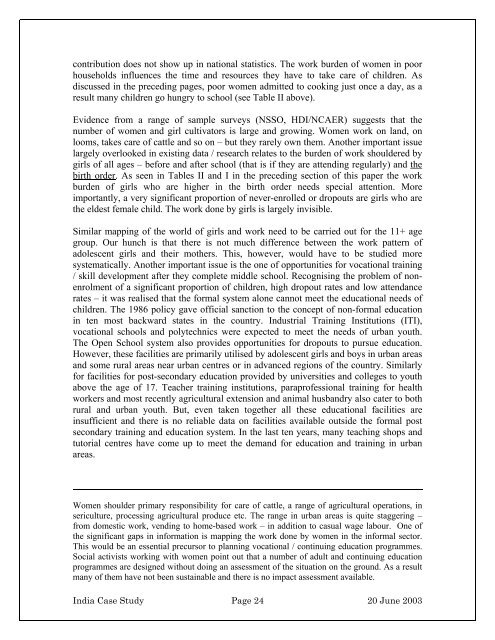Where are we today with respect to girls' education
Where are we today with respect to girls' education
Where are we today with respect to girls' education
- No tags were found...
Create successful ePaper yourself
Turn your PDF publications into a flip-book with our unique Google optimized e-Paper software.
contribution does not show up in national statistics. The work burden of women in poorhouseholds influences the time and resources they have <strong>to</strong> take c<strong>are</strong> of children. Asdiscussed in the preceding pages, poor women admitted <strong>to</strong> cooking just once a day, as <strong>are</strong>sult many children go hungry <strong>to</strong> school (see Table II above).Evidence from a range of sample surveys (NSSO, HDI/NCAER) suggests that thenumber of women and girl cultiva<strong>to</strong>rs is large and growing. Women work on land, onlooms, takes c<strong>are</strong> of cattle and so on – but they r<strong>are</strong>ly own them. Another important issuelargely overlooked in existing data / research relates <strong>to</strong> the burden of work shouldered bygirls of all ages – before and after school (that is if they <strong>are</strong> attending regularly) and thebirth order. As seen in Tables II and I in the preceding section of this paper the workburden of girls who <strong>are</strong> higher in the birth order needs special attention. Moreimportantly, a very significant proportion of never-enrolled or dropouts <strong>are</strong> girls who <strong>are</strong>the eldest female child. The work done by girls is largely invisible.Similar mapping of the world of girls and work need <strong>to</strong> be carried out for the 11+ agegroup. Our hunch is that there is not much difference bet<strong>we</strong>en the work pattern ofadolescent girls and their mothers. This, ho<strong>we</strong>ver, would have <strong>to</strong> be studied moresystematically. Another important issue is the one of opportunities for vocational training/ skill development after they complete middle school. Recognising the problem of nonenrolmen<strong>to</strong>f a significant proportion of children, high dropout rates and low attendancerates – it was realised that the formal system alone cannot meet the <strong>education</strong>al needs ofchildren. The 1986 policy gave official sanction <strong>to</strong> the concept of non-formal <strong>education</strong>in ten most backward states in the country. Industrial Training Institutions (ITI),vocational schools and polytechnics <strong>we</strong>re expected <strong>to</strong> meet the needs of urban youth.The Open School system also provides opportunities for dropouts <strong>to</strong> pursue <strong>education</strong>.Ho<strong>we</strong>ver, these facilities <strong>are</strong> primarily utilised by adolescent girls and boys in urban <strong>are</strong>asand some rural <strong>are</strong>as near urban centres or in advanced regions of the country. Similarlyfor facilities for post-secondary <strong>education</strong> provided by universities and colleges <strong>to</strong> youthabove the age of 17. Teacher training institutions, paraprofessional training for healthworkers and most recently agricultural extension and animal husbandry also cater <strong>to</strong> bothrural and urban youth. But, even taken <strong>to</strong>gether all these <strong>education</strong>al facilities <strong>are</strong>insufficient and there is no reliable data on facilities available outside the formal postsecondary training and <strong>education</strong> system. In the last ten years, many teaching shops andtu<strong>to</strong>rial centres have come up <strong>to</strong> meet the demand for <strong>education</strong> and training in urban<strong>are</strong>as.Women shoulder primary responsibility for c<strong>are</strong> of cattle, a range of agricultural operations, insericulture, processing agricultural produce etc. The range in urban <strong>are</strong>as is quite staggering –from domestic work, vending <strong>to</strong> home-based work – in addition <strong>to</strong> casual wage labour. One ofthe significant gaps in information is mapping the work done by women in the informal sec<strong>to</strong>r.This would be an essential precursor <strong>to</strong> planning vocational / continuing <strong>education</strong> programmes.Social activists working <strong>with</strong> women point out that a number of adult and continuing <strong>education</strong>programmes <strong>are</strong> designed <strong>with</strong>out doing an assessment of the situation on the ground. As a resultmany of them have not been sustainable and there is no impact assessment available.India Case Study Page 24 20 June 2003












